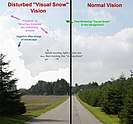Visual snow
Visual snow, also known as visual static, is a condition in which people see white or black dots in parts or the whole of their visual fields.[3][4] The problem is typically always present and can last years.[5]
| Visual snow | |
|---|---|
| Other names | Persistent positive visual phenomenon,[1] visual static, aeropsia |
 | |
| Animated example of visual snow-like noise | |
| Specialty | Neurology, Neuro-ophthalmology |
| Usual onset | Early to middle adulthood[1] |
| Causes | Unknown[2] |
| Differential diagnosis | Migraine aura[3] |
Medications that may be used to treat the condition include lamotrigine, acetazolamide, or verapamil.[4] These do not always result in benefits, however.[3][2]
Signs and symptoms

Some neuro-ophthalmologists believe that visual snow is not a medical condition, but a poorly understood symptom. People report seeing "snow", much like the visual noise on a TV screen after transmission ends. A 2010 study by Raghaven et al. hypothesizes that what the patients see as "snow" is their own intrinsic visual noise.[6]
Many report more visual snow in low light conditions. This has a natural explanation. "The intrinsic dark noise of primate cones is equivalent to ~4000 absorbed photons per second at mean light levels below this the cone signals are dominated by intrinsic noise".[7]
In addition to visual snow, many of those affected have other types of visual disturbances such as starbursts, increased afterimages, floaters, trails, and many others.[8]
Comorbidities
Migraine and migraine with aura are common comorbidities. However, comorbid migraine worsens some of the additional visual symptoms and tinnitus seen in "visual snow" syndrome. This might bias research studies by patients with migraine being more likely to offer study participation than those without migraine due to having more severe symptoms. In contrast to migraine, comorbidity of typical migraine aura does not appear to worsen symptoms.[9]
Patients with visual "snow" have normal equivalent input noise levels. Denis Pelli and others' measurements assess whether visual-snow patients have increased levels of intrinsic visual noise.[6]
Causes
The causes are unclear.[2] The underlying mechanism is believed to involve excessive excitability of neurons within the cortex of the brain,[4] specifically the right lingual gyrus and left cerebellar anterior lobe of the brain.[9]
Persisting visual snow can feature as a leading addition to a migraine complication called persistent aura without infarction,[10] commonly referred to as persistent migraine aura (PMA). In other clinical sub-forms of migraine headache may be absent and the migraine aura may not take the typical form of the zigzagged fortification spectrum (scintillating scotoma), but manifests with a large variety of focal neurological symptoms.[11]
The role of hallucinogens in visual snow is not clear. Hallucinogen persisting perception disorder (HPPD), a condition caused by hallucinogenic drug use, is sometimes linked to visual snow,[12] but both the connection of visual snow to HPPD[13] and the cause and prevalence of HPPD is disputed.[14] Most of the evidence for both is generally anecdotal, and subject to spotlight fallacy.[13][14]
Diagnosis
Proposed diagnostic criteria for the "visual snow" syndrome:[15][16]
- Dynamic, continuous, tiny dots in the entire visual field.
- Additional visual symptoms of at least two of the following four types:
- Palinopsia (visual trailing and afterimages)
- Enhanced entoptic phenomena (floaters, photopsia, blue field entoptic phenomenon, self-light of the eye)
- Photophobia
- Impaired night vision
- Symptoms are not consistent with typical migraine aura.
- Symptoms are not attributed to another disorder (ophthalmological, drug abuse).
Treatments
There is no established treatment for visual snow. It is difficult to resolve visual snow with treatment, but it is possible to reduce symptoms and improve quality of life through treatment.[4]
Medications that may be used include lamotrigine, acetazolamide, or verapamil,[4] but these do not always result in benefits.[3][2]
References
- Licht, Joseph; Ireland, Kathryn; Kay, Matthew. "Visual Snow: Clinical Correlations and Workup A Case Series". researchgate.net. Larkin Community Hospital. Retrieved 3 September 2017.
- Brodsky, Michael C. (2016). Pediatric Neuro-Ophthalmology. Springer. p. 285. ISBN 9781493933846.
- Dodick, David; Silberstein, Stephen D. (2016). Migraine. Oxford University Press. p. 53. ISBN 9780199793617.
- Bou Ghannam, A; Pelak, VS (March 2017). "Visual snow: a potential cortical hyperexcitability syndrome". Current Treatment Options in Neurology. 19 (3): 9. doi:10.1007/s11940-017-0448-3. PMID 28349350.
- Schankin, CJ; Goadsby, PJ (June 2015). "Visual snow--persistent positive visual phenomenon distinct from migraine aura". Current Pain and Headache Reports. 19 (6): 23. doi:10.1007/s11916-015-0497-9. PMID 26021756.
- Raghavan, Manoj; Remler, Bernd F.; Rozman1, Stephanie; Pelli, Denis G. (2010). "Patients with visual 'snow' have normal equivalent input noise levels" (PDF). Investigative Ophthalmology & Visual Science (51). Retrieved 2017-04-12.
- Dunn, FA; Rieke, F (August 2006). "The impact of photoreceptor noise on retinal gain controls". Current Opinion in Neurobiology. 16 (4): 363–70. doi:10.1016/j.conb.2006.06.013. PMID 16837189.
- Podoll K, Dahlem M, Greene S. Persistent migraine aura symptoms aka visual snow. (archived Feb 8, 2012)
- Schankin, CJ, Maniyar, FH, Sprenger, T, Chou, DE, Eller, M, Goadsby, PJ, 2014, The Relation Between Migraine, Typical Migraine Aura and "Visual Snow", Headache, doi:10.1111/head.12378
- International Headache Society. The International Classification of Headache Disorders, 2nd edition" Cephalalgia 2004; 24 (suppl. 1): 1-160.
- "Headache". casemed.case.edu. Retrieved 2019-11-04.
- Abraham HD (1983). "Visual phenomenology of the LSD flashback". Arch Gen Psychiatry. 40 (8): 884–889. doi:10.1001/archpsyc.1983.01790070074009.
- Schankin, C.; Maniyar, F.; Hoffmann, J.; Chou, D.; Goadsby, P. (22 April 2012). "Visual Snow: A New Disease Entity Distinct from Migraine Aura (S36.006)". Neurology. 78 (Meeting Abstracts 1): S36.006. doi:10.1212/WNL.78.1_MeetingAbstracts.S36.006.
- Halpern, J (1 March 2003). "Hallucinogen persisting perception disorder: what do we know after 50 years?". Drug and Alcohol Dependence. 69 (2): 109–119. doi:10.1016/S0376-8716(02)00306-X. PMID 12609692.
- Schankin, Christoph J.; Maniyar, Farooq H.; Digre, Kathleen B.; Goadsby, Peter J. (2014-03-18). "'Visual snow' – a disorder distinct from persistent migraine aura". Brain. 137 (5): 1419–1428. doi:10.1093/brain/awu050. ISSN 1460-2156. PMID 24645145.
- "Headache Classification Committee of the International Headache Society (IHS) The International Classification of Headache Disorders, 3rd edition". Cephalalgia. 38 (1): 1–211. 2018-01-25. doi:10.1177/0333102417738202. ISSN 0333-1024. PMID 29368949.